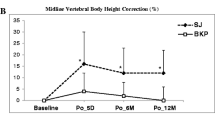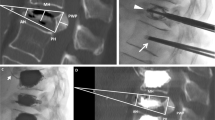Abstract
Summary
This pilot monocenter study in 30 patients with painful osteoporotic vertebral compression fractures compared two vertebral augmentation procedures. Over a 3-year post-surgery follow-up, pain/disability/quality of life remained significantly improved with both balloon kyphoplasty and SpineJack® techniques, but the latter allowed better vertebral body height restoration/kyphosis correction.
Introduction
Patient follow-up rarely exceed 2 years in trials comparing vertebral augmentation procedures for the treatment of painful osteoporotic vertebral compression fractures (VCFs). This pilot, investigator-initiated, prospective study aimed to compare long-term results of SpineJack® (SJ) and balloon kyphoplasty (BKP). Preliminary results showed that SJ resulted in a better restoration of vertebral heights and angles, maintained over 12 months.
Methods
Thirty patients were randomized to SJ (n = 15) or BKP (n = 15). Clinical endpoints were analgesic consumption, back pain intensity (visual analog scale (VAS)), the Oswestry Disability Index (ODI), and quality of life (EQ-VAS score). They were recorded preoperatively, at 5 days (except EQ-VAS), 1, 3, 6, 12, and 36 months post-surgery. Spine X-rays were taken 48 h prior to the procedure and 5 days, 6, 12, and 36 months after.
Results
Clinical improvements were observed with both procedures over the 3-year period without significant inter-group differences, but the final mean EQ-5Dindex score was significantly in favor of the SJ group (0.93 ± 0.11 vs 0.81 ± 0.09; p = 0.007). Vertebral height restoration/kyphotic correction was still evident at 36 months with a greater mean correction of anterior (10 ± 13% vs 2 ± 8% for BKP, p = 0.007) and central height (10 ± 11% vs 3 ± 7% for BKP, p = 0.034) and a larger correction of the vertebral body angle (− 5.0° ± 5.1° vs 0.4° ± 3.4°; p = 0.003) for SJ group.
Conclusions
In this study, both techniques displayed very good long-term clinical efficiency and safety in patients with osteoporotic VCFs. Over the 3-year follow-up, vertebral body height restoration/kyphosis correction was better with the SpineJack® procedure.



Similar content being viewed by others
Change history
18 January 2019
The author list was incomplete. The complete list of authors is the following: D. Noriega, F. Rodrίguez-Monsalve, R. Ramajo, I.Sánchez-Lite, B. Toribio, F. Ardura. The corresponding author regrets sincerely this error. The original article got update.
References
Van der Klift M, De Laet CE, McCloskey EV, Hofman A, Pols HA (2002) The incidence of vertebral fractures in men and women: the Rotterdam study. J Bone Miner Res 17:1051–1056
Ballane G, Cauley JA, Luckey MM, El-Hajj Fuleihan G (2015) Worldwide prevalence and incidence of osteoporotic vertebral fractures. Osteoporos Int 28(5):1531–1542
Johnell O, Kanis JA (2006) An estimate of the worldwide prevalence and disability associated with osteoporotic fractures. Osteoporos Int 17(12):1726–1733
Lindsay R, Burge RT, Strauss DM (2005) One-year outcomes and costs following a vertebral fracture. Osteoporos Int 16:78–85
Lau E, Ong K, Kurtz S, Schmier J, Edidin A (2008) Mortality following the diagnosis of a vertebral compression fracture in the Medicare population. J Bone Joint Surg Am 90:1479–1486
Majumdar SR, Kim N, Colman I, Chahal AM, Raymond G, Jen H, Siminoski KG, Hanley DA, Rowe BH (2005) Incidental vertebral fractures discovered with chest radiography in the emergency department: prevalence, recognition, and osteoporosis management in a cohort of elderly patients. Arch Intern Med 165(8):905–909
European Prospective Osteoporosis Study (EPOS) Group, Felsenberg D, Silman AJ, Lunt M et al (2002) Incidence of vertebral fractures in Europe: results from the European Prospective Osteoporosis Study (EPOS). J Bone Miner Res 17:716–724
Han SL, Wan SL, Li QT, Xu DT, Zang HM, Chen NJ, Chen LY, Zhang WP, Luan C, Yang F, Xu ZW (2015) Is vertebroplasty a risk factor for subsequent vertebral fracture, meta-analysis of published evidence? Osteoporos Int 26:113–122
Klazen CA, Verhaar HJ, Lohle PN, Lampmann LE, Juttmann JR, Schoemaker MC, van Everdingen KJ, Muller AF, Mali WP, de Vries J (2010) Clinical course of pain in acute osteoporotic vertebral compression fractures. J Vasc Interv Radiol 21:1405–1409
NICE Guidance. Percutaneous vertebroplasty and percutaneous balloon kyphoplasty for treating osteoporotic vertebral compression fractures. Technology appraisal guidance [TA279], 24 April 2013. https://www.nice.org.uk/guidance/ta279
Papanastassiou ID, Filis A, Gerochristou MA, Vrionis FD (2014) Controversial issues in kyphoplasty and vertebroplasty in osteoporotic vertebral fractures. Biomed Res Int 2014:934206
Edidin AA, Ong KL, Lau E, Schmier JK, Kemner JE, Kurtz SM (2012) Cost-effectiveness analysis of treatments for vertebral compression fractures. Appl Health Econ Health Policy 10:273–284
Chen AT, Cohen DB, Skolasky RL (2013) Impact of nonoperative treatment, vertebroplasty, and kyphoplasty on survival and morbidity after vertebral compression fracture in the Medicare population. J Bone Joint Surg Am 95:1729–1736
Vanni D, Galzio R, Kazakova A, Pantalone A, Grillea G, Bartolo M, Salini V, Magliani V (2016) Third-generation percutaneous vertebral augmentation systems. J Spine Surg 2(1):13–20
Krüger A, Baroud G, Noriega D, Figiel J, Dorschel C, Ruchholtz S, Oberkircher L (2013) Height restoration and maintenance after treating unstable osteoporotic vertebral compression fractures by cement augmentation is dependent on the cement volume used. Clin Biomech 28:725–730
Krüger A, Oberkircher L, Figiel J, Floßdorf F, Bolzinger F, Noriega DC, Ruchholtz S (2015) Height restoration of osteoporotic vertebral compression fractures using different intravertebral reduction devices: a cadaveric study. Spine J 15:1092–1098
Noriega DC, Ramajo RH, Lite IS, Toribio B, Corredera R, Ardura F, Krüger A (2016) Safety and clinical performance of kyphoplasty and SpineJack procedures in the treatment of osteoporotic vertebral compression fractures: a pilot, monocentric, investigator-initiated study. Osteoporos Int 27(6):2047–2055
Vanni D, Pantalone A, Bigossi F, Pineto F, Lucantoni D, Salini V (2012) New perspective for third generation percutaneous vertebral augmentation procedures: preliminary results at 12 months. J Craniovertebr Junction Spine 3:47–51
Vogler D, Paillex R, Norberg M, de Goumoëns P, Cabri J (2008) Cross-cultural validation of the Oswestry disability index in French. Ann Readapt Med Phys 51:379–385
Brooks R, Rabin R, Charro F (2003) The measurement and valuation of health status using EQ-5D: a European perspective. Evidence from the EuroQol BIOMED Research programme. Editors: Brooks, Richard, Rabin, Rosalind, de Charro
Schulze M, Trautwein F, Vordemvenne T, Raschke M, Heuer F (2011) A method to perform spinal motion analysis from functional X-ray images. J Biomech 44:1740–1746
MedDRA term selection: points to consider. ICH endorsed guide for MedDRA users. Release 4.2, based on MedDRA Version 14.1, October 2011. http://www.meddra.org/sites/default/files/guidance/file/9491-1410_termselptc_r4_2_sep2011.pdf
Genant HK, Wu CY, van Kuijk C, Nevitt MC (1993) Vertebral fracture assessment using a semiquantitative technique. J Bone Miner Res 8(9):1137–1148
Yeom JS, Kim WJ, Choy WS, Lee CK, Chang BS, Kang JW (2003) Leakage of cement in percutaneous transpedicular vertebroplasty for painful osteoporotic compression fractures. J Bone Joint Surg Br 85(1):83–89
Walters SJ, Brazier JE (2005) Comparison of the minimally important difference for two health state utility measures: EQ-5D and SF-6D. Qual Life Res 14:1523–1532
Le QA, Doctor JN, Zoellner LA, Feeny NC (2013) Minimal clinically important differences for the EQ-5D and QWB-SA in Post-traumatic Stress Disorder (PTSD): results from a Doubly Randomized Preference Trial (DRPT). Health Qual Life Outcomes 11:59
Collins SL, Moore RA, McQuay HJ (1997) The visual analogue pain intensity scale: what is moderate pain in millimetres? Pain 72:95–97
Ostelo RW, Deyo RA, Stratford P, Waddell G, Croft P, Von Korff M, Bouter LM, de Vet HC (2008) Interpreting change scores for pain and functional status in low back pain: towards international consensus regarding minimal important change. Spine (Phila Pa 1976) 33:90–94
Van Meirhaeghe J, Bastian L, Boonen S, Ranstam J, Tillman JB, Wardlaw D (2013) FREE investigators. A randomized trial of balloon kyphoplasty and nonsurgical management for treating acute vertebral compression fractures: vertebral body kyphosis correction and surgical parameters. Spine (Phila Pa 1976) 38(12):971–983
Zhang H, Xu C, Zhang T, Gao Z, Zhang T (2017) Does percutaneous vertebroplasty or balloon kyphoplasty for osteoporotic vertebral compression fractures increase the incidence of new vertebral fractures? A meta-analysis. Pain Physician 20(1):E13–E28
Yi X, Lu H, Tian F, Wang Y, Li C, Liu H, Liu X, Li H (2014) Recompression in new levels after percutaneous vertebroplasty and kyphoplasty compared with conservative treatment. Arch Orthop Trauma Surg 134:21–30
Tutton SM, Pflugmacher R, Davidian M, Beall DP, Facchini FR, Garfin SR (2015) KAST study: the kiva® system as a vertebral augmentation treatment - a safety and effectiveness trial: a randomized, non-inferiority trial comparing the kiva® system to balloon kyphoplasty in treatment of osteoporotic vertebral compression fractures. Spine (Phila Pa 1976) 40:865–875
Dohm M, Black C, Dacre A, Tillman JB, Fueredi G, KAVIAR investigators (2014) A randomized trial comparing balloon kyphoplasty and vertebroplasty for vertebral compression fractures (VCFs) due to osteoporosis. AJNR 35(12):2227–2236
Liu JT, Li CS, Chang CS, Liao WJ (2015) Long-term follow-up study of osteoporotic vertebral compression fracture treated using balloon kyphoplasty and vertebroplasty. J Neurosurg Spine 23(1):94–98
Baz AB, Akalin S, Kiliçaslan ÖF, Tokatman B, Arik H, Duygun F (2016) Efficiency of balloon kyphoplasty in the treatment of osteoporotic vertebral compression fractures. Kobe J Med Sci 62(3):E49–E54
Faloon MJ, Ruoff M, Deshpande C, Hohman D, Dunn C, Beckloff N, Patel DV (2015) Risk factors associated with adjacent and remote- level pathologic vertebral compression fracture following balloon kyphoplasty: 2-year follow-up comparison versus conservative treatment. J Long-Term Eff Med Implants 25(4):313–319
Wardlaw D, Cummings SR, Van Meirhaeghe J, Bastian L, Tillman JB, Ranstam J, Eastell R, Shabe P, Talmadge K, Boonen S (2009) Efficacy and safety of balloon kyphoplasty compared with non-surgical care for vertebral compression fracture (FREE): a randomised controlled trial. Lancet 373(9668):1016–1024
Deibert CP, Gandhoke GS, Paschel EE, Gerszten PC (2016) A longitudinal cohort investigation of the development of symptomatic adjacent level compression fractures following balloon-assisted kyphoplasty in a series of 726 patients. Pain Physician 19(8):E1167–E1172
Author information
Authors and Affiliations
Corresponding author
Ethics declarations
Conflicts of interest
None.
Additional information
Publisher’s note
Springer Nature remains neutral with regard to jurisdictional claims in published maps and institutional affiliations.
The original version of this article was revised: The author list was incomplete
Rights and permissions
About this article
Cite this article
Noriega, D.C., Rodrίguez-Monsalve, F., Ramajo, R. et al. Long-term safety and clinical performance of kyphoplasty and SpineJack® procedures in the treatment of osteoporotic vertebral compression fractures: a pilot, monocentric, investigator-initiated study. Osteoporos Int 30, 637–645 (2019). https://doi.org/10.1007/s00198-018-4773-5
Received:
Accepted:
Published:
Issue Date:
DOI: https://doi.org/10.1007/s00198-018-4773-5




